Staff Awareness of Perioperative Hypothermia: A Literature Review
VerifiedAdded on 2023/03/30
|15
|3393
|132
Literature Review
AI Summary
This literature review explores the level of awareness among healthcare staff regarding perioperative hypothermia, a common but often avoidable medical event. The review emphasizes the importance of maintaining normothermia for improved patient recovery after surgery. It delves into the prevalence of perioperative hypothermia, its associated risk factors, and the significance of early detection and prevention measures. The methodology includes a three-stage process of planning, conducting, and reporting, adhering to a 12-step outline. The review uses search terms like 'perioperative hypothermia,' 'staff awareness,' and 'healthcare professionals' across CINAHL and MEDLINE databases. The study underscores the need for adequate clinical knowledge among healthcare professionals to prevent adverse health outcomes related to perioperative hypothermia.
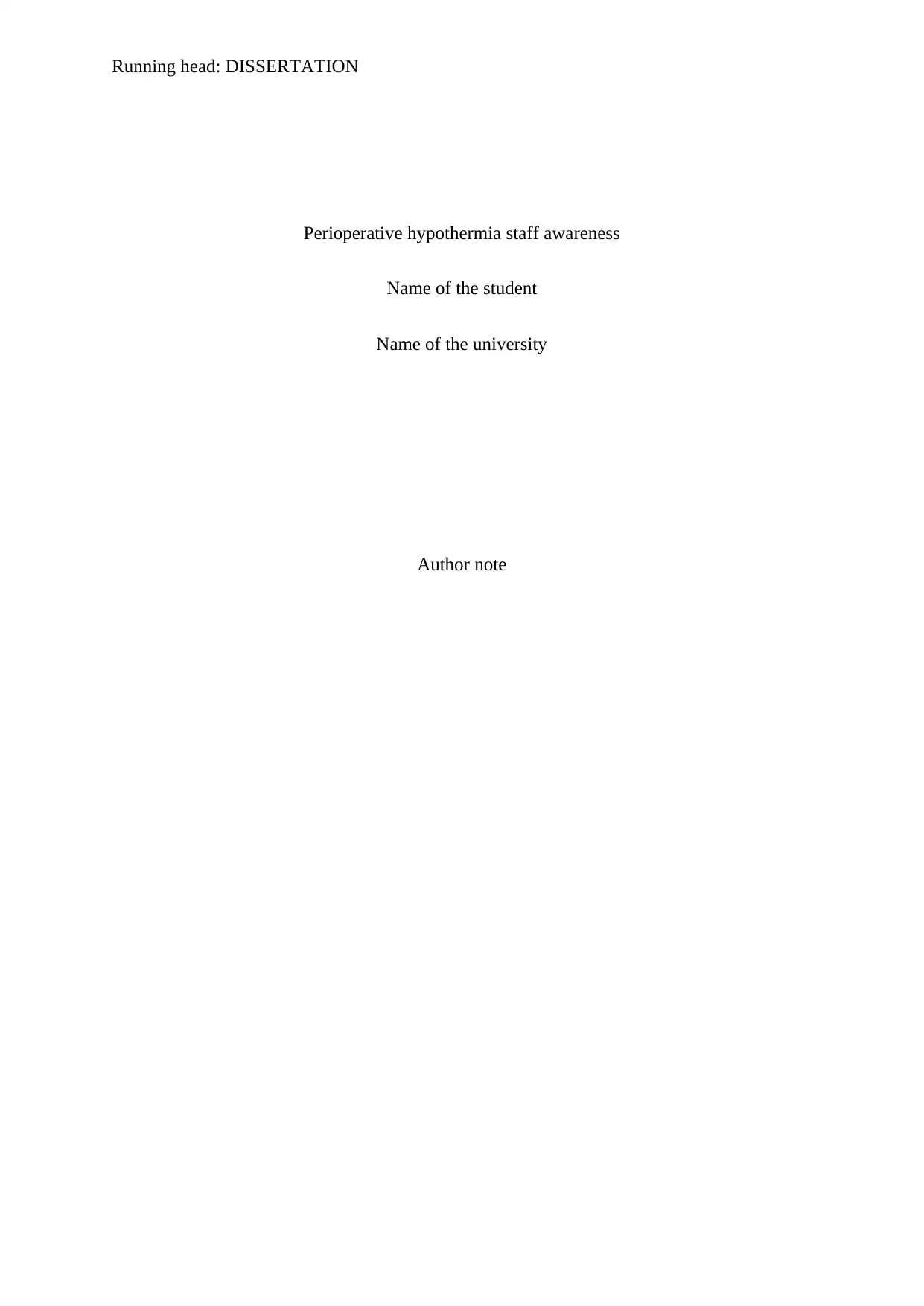
Running head: DISSERTATION
Perioperative hypothermia staff awareness
Name of the student
Name of the university
Author note
Perioperative hypothermia staff awareness
Name of the student
Name of the university
Author note
Paraphrase This Document
Need a fresh take? Get an instant paraphrase of this document with our AI Paraphraser
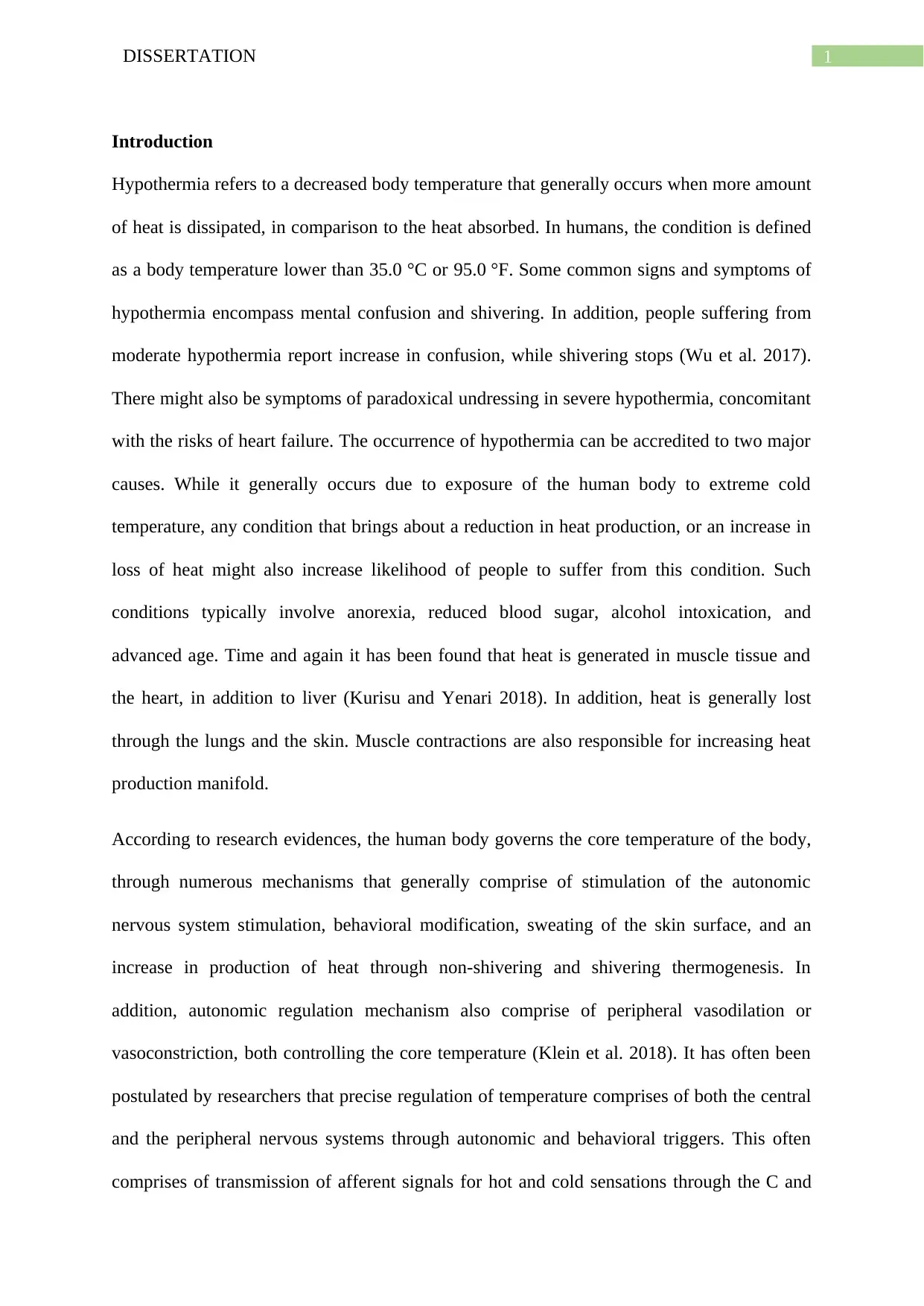
1DISSERTATION
Introduction
Hypothermia refers to a decreased body temperature that generally occurs when more amount
of heat is dissipated, in comparison to the heat absorbed. In humans, the condition is defined
as a body temperature lower than 35.0 °C or 95.0 °F. Some common signs and symptoms of
hypothermia encompass mental confusion and shivering. In addition, people suffering from
moderate hypothermia report increase in confusion, while shivering stops (Wu et al. 2017).
There might also be symptoms of paradoxical undressing in severe hypothermia, concomitant
with the risks of heart failure. The occurrence of hypothermia can be accredited to two major
causes. While it generally occurs due to exposure of the human body to extreme cold
temperature, any condition that brings about a reduction in heat production, or an increase in
loss of heat might also increase likelihood of people to suffer from this condition. Such
conditions typically involve anorexia, reduced blood sugar, alcohol intoxication, and
advanced age. Time and again it has been found that heat is generated in muscle tissue and
the heart, in addition to liver (Kurisu and Yenari 2018). In addition, heat is generally lost
through the lungs and the skin. Muscle contractions are also responsible for increasing heat
production manifold.
According to research evidences, the human body governs the core temperature of the body,
through numerous mechanisms that generally comprise of stimulation of the autonomic
nervous system stimulation, behavioral modification, sweating of the skin surface, and an
increase in production of heat through non-shivering and shivering thermogenesis. In
addition, autonomic regulation mechanism also comprise of peripheral vasodilation or
vasoconstriction, both controlling the core temperature (Klein et al. 2018). It has often been
postulated by researchers that precise regulation of temperature comprises of both the central
and the peripheral nervous systems through autonomic and behavioral triggers. This often
comprises of transmission of afferent signals for hot and cold sensations through the C and
Introduction
Hypothermia refers to a decreased body temperature that generally occurs when more amount
of heat is dissipated, in comparison to the heat absorbed. In humans, the condition is defined
as a body temperature lower than 35.0 °C or 95.0 °F. Some common signs and symptoms of
hypothermia encompass mental confusion and shivering. In addition, people suffering from
moderate hypothermia report increase in confusion, while shivering stops (Wu et al. 2017).
There might also be symptoms of paradoxical undressing in severe hypothermia, concomitant
with the risks of heart failure. The occurrence of hypothermia can be accredited to two major
causes. While it generally occurs due to exposure of the human body to extreme cold
temperature, any condition that brings about a reduction in heat production, or an increase in
loss of heat might also increase likelihood of people to suffer from this condition. Such
conditions typically involve anorexia, reduced blood sugar, alcohol intoxication, and
advanced age. Time and again it has been found that heat is generated in muscle tissue and
the heart, in addition to liver (Kurisu and Yenari 2018). In addition, heat is generally lost
through the lungs and the skin. Muscle contractions are also responsible for increasing heat
production manifold.
According to research evidences, the human body governs the core temperature of the body,
through numerous mechanisms that generally comprise of stimulation of the autonomic
nervous system stimulation, behavioral modification, sweating of the skin surface, and an
increase in production of heat through non-shivering and shivering thermogenesis. In
addition, autonomic regulation mechanism also comprise of peripheral vasodilation or
vasoconstriction, both controlling the core temperature (Klein et al. 2018). It has often been
postulated by researchers that precise regulation of temperature comprises of both the central
and the peripheral nervous systems through autonomic and behavioral triggers. This often
comprises of transmission of afferent signals for hot and cold sensations through the C and
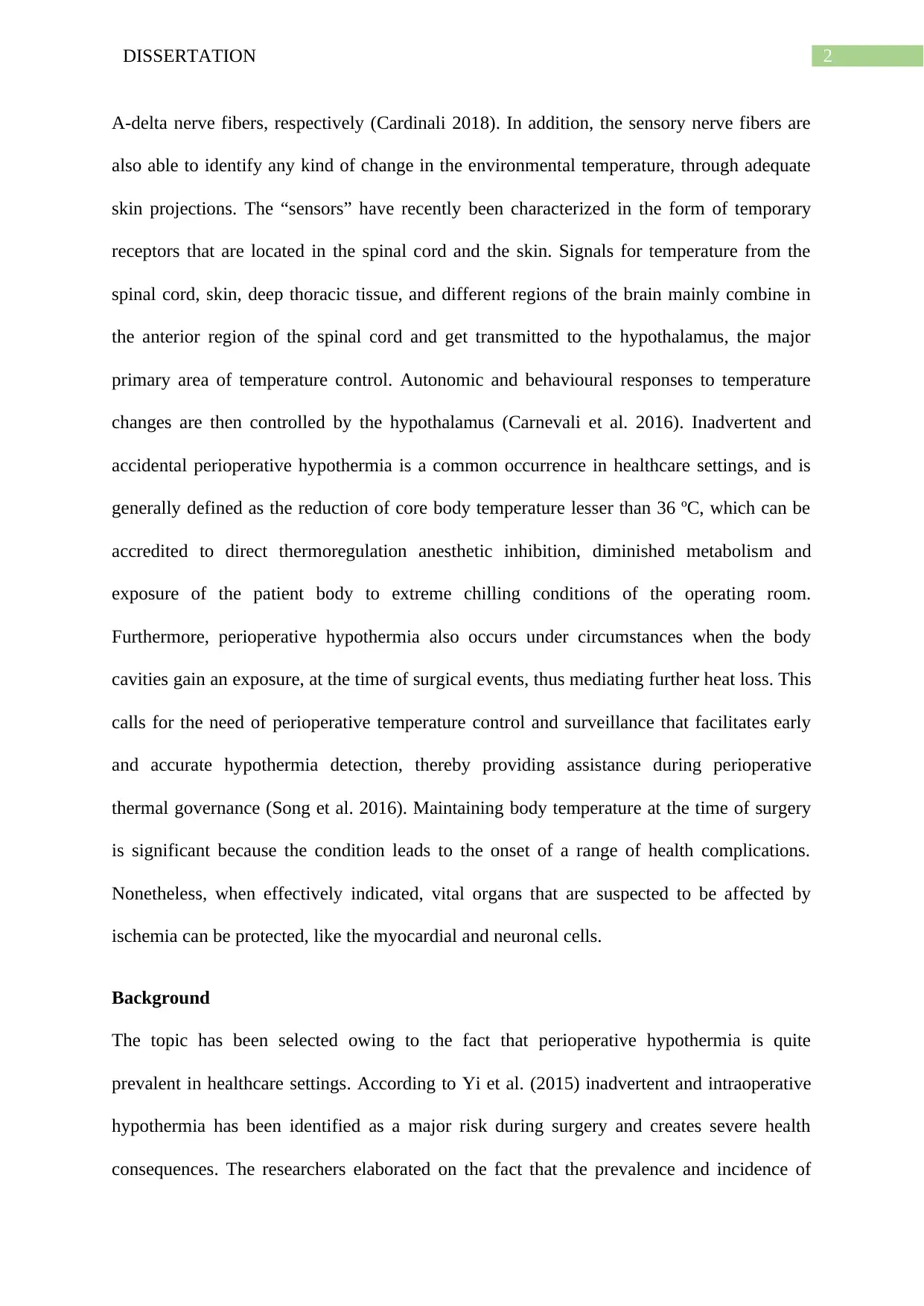
2DISSERTATION
A-delta nerve fibers, respectively (Cardinali 2018). In addition, the sensory nerve fibers are
also able to identify any kind of change in the environmental temperature, through adequate
skin projections. The “sensors” have recently been characterized in the form of temporary
receptors that are located in the spinal cord and the skin. Signals for temperature from the
spinal cord, skin, deep thoracic tissue, and different regions of the brain mainly combine in
the anterior region of the spinal cord and get transmitted to the hypothalamus, the major
primary area of temperature control. Autonomic and behavioural responses to temperature
changes are then controlled by the hypothalamus (Carnevali et al. 2016). Inadvertent and
accidental perioperative hypothermia is a common occurrence in healthcare settings, and is
generally defined as the reduction of core body temperature lesser than 36 ºC, which can be
accredited to direct thermoregulation anesthetic inhibition, diminished metabolism and
exposure of the patient body to extreme chilling conditions of the operating room.
Furthermore, perioperative hypothermia also occurs under circumstances when the body
cavities gain an exposure, at the time of surgical events, thus mediating further heat loss. This
calls for the need of perioperative temperature control and surveillance that facilitates early
and accurate hypothermia detection, thereby providing assistance during perioperative
thermal governance (Song et al. 2016). Maintaining body temperature at the time of surgery
is significant because the condition leads to the onset of a range of health complications.
Nonetheless, when effectively indicated, vital organs that are suspected to be affected by
ischemia can be protected, like the myocardial and neuronal cells.
Background
The topic has been selected owing to the fact that perioperative hypothermia is quite
prevalent in healthcare settings. According to Yi et al. (2015) inadvertent and intraoperative
hypothermia has been identified as a major risk during surgery and creates severe health
consequences. The researchers elaborated on the fact that the prevalence and incidence of
A-delta nerve fibers, respectively (Cardinali 2018). In addition, the sensory nerve fibers are
also able to identify any kind of change in the environmental temperature, through adequate
skin projections. The “sensors” have recently been characterized in the form of temporary
receptors that are located in the spinal cord and the skin. Signals for temperature from the
spinal cord, skin, deep thoracic tissue, and different regions of the brain mainly combine in
the anterior region of the spinal cord and get transmitted to the hypothalamus, the major
primary area of temperature control. Autonomic and behavioural responses to temperature
changes are then controlled by the hypothalamus (Carnevali et al. 2016). Inadvertent and
accidental perioperative hypothermia is a common occurrence in healthcare settings, and is
generally defined as the reduction of core body temperature lesser than 36 ºC, which can be
accredited to direct thermoregulation anesthetic inhibition, diminished metabolism and
exposure of the patient body to extreme chilling conditions of the operating room.
Furthermore, perioperative hypothermia also occurs under circumstances when the body
cavities gain an exposure, at the time of surgical events, thus mediating further heat loss. This
calls for the need of perioperative temperature control and surveillance that facilitates early
and accurate hypothermia detection, thereby providing assistance during perioperative
thermal governance (Song et al. 2016). Maintaining body temperature at the time of surgery
is significant because the condition leads to the onset of a range of health complications.
Nonetheless, when effectively indicated, vital organs that are suspected to be affected by
ischemia can be protected, like the myocardial and neuronal cells.
Background
The topic has been selected owing to the fact that perioperative hypothermia is quite
prevalent in healthcare settings. According to Yi et al. (2015) inadvertent and intraoperative
hypothermia has been identified as a major risk during surgery and creates severe health
consequences. The researchers elaborated on the fact that the prevalence and incidence of
⊘ This is a preview!⊘
Do you want full access?
Subscribe today to unlock all pages.

Trusted by 1+ million students worldwide
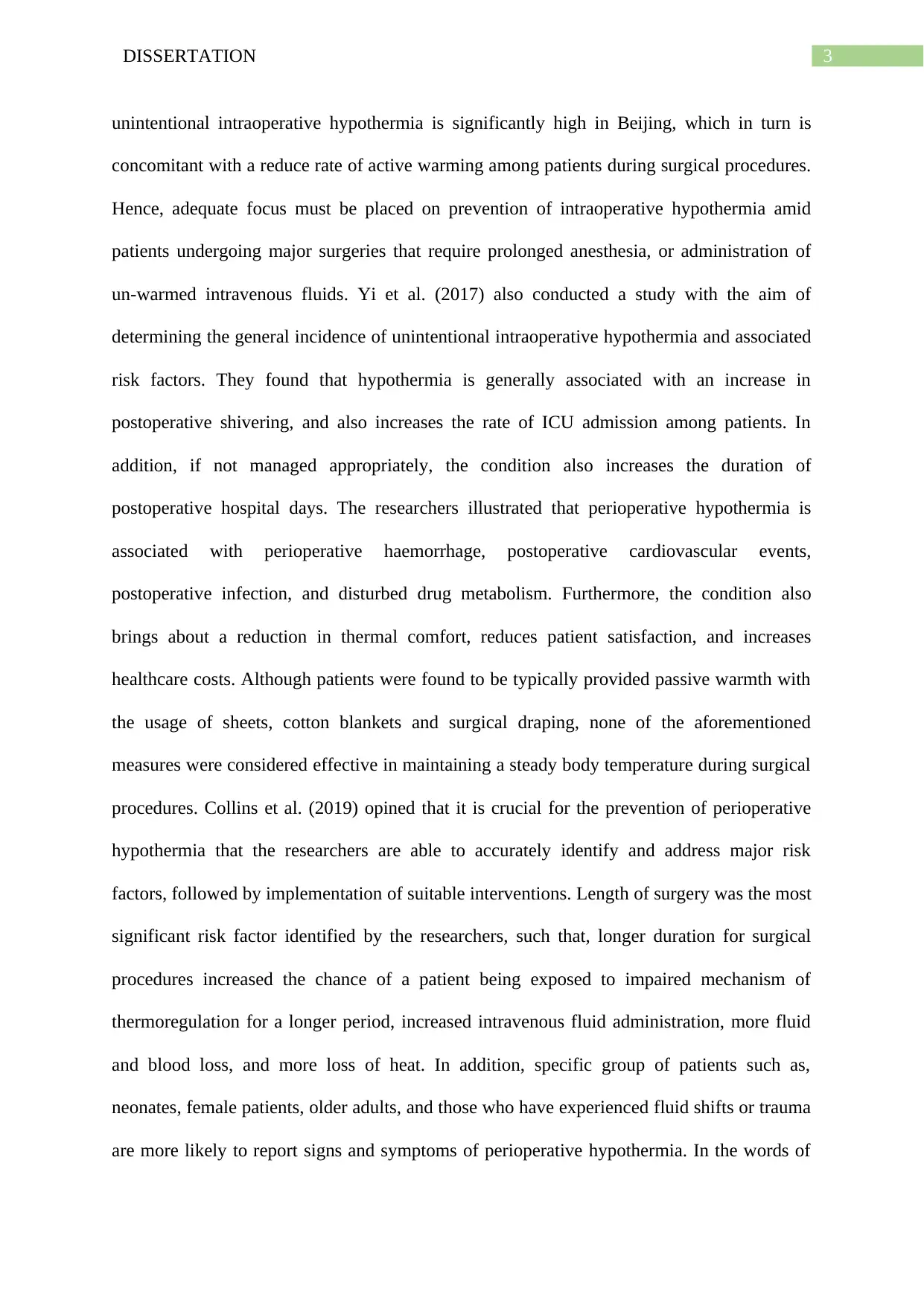
3DISSERTATION
unintentional intraoperative hypothermia is significantly high in Beijing, which in turn is
concomitant with a reduce rate of active warming among patients during surgical procedures.
Hence, adequate focus must be placed on prevention of intraoperative hypothermia amid
patients undergoing major surgeries that require prolonged anesthesia, or administration of
un-warmed intravenous fluids. Yi et al. (2017) also conducted a study with the aim of
determining the general incidence of unintentional intraoperative hypothermia and associated
risk factors. They found that hypothermia is generally associated with an increase in
postoperative shivering, and also increases the rate of ICU admission among patients. In
addition, if not managed appropriately, the condition also increases the duration of
postoperative hospital days. The researchers illustrated that perioperative hypothermia is
associated with perioperative haemorrhage, postoperative cardiovascular events,
postoperative infection, and disturbed drug metabolism. Furthermore, the condition also
brings about a reduction in thermal comfort, reduces patient satisfaction, and increases
healthcare costs. Although patients were found to be typically provided passive warmth with
the usage of sheets, cotton blankets and surgical draping, none of the aforementioned
measures were considered effective in maintaining a steady body temperature during surgical
procedures. Collins et al. (2019) opined that it is crucial for the prevention of perioperative
hypothermia that the researchers are able to accurately identify and address major risk
factors, followed by implementation of suitable interventions. Length of surgery was the most
significant risk factor identified by the researchers, such that, longer duration for surgical
procedures increased the chance of a patient being exposed to impaired mechanism of
thermoregulation for a longer period, increased intravenous fluid administration, more fluid
and blood loss, and more loss of heat. In addition, specific group of patients such as,
neonates, female patients, older adults, and those who have experienced fluid shifts or trauma
are more likely to report signs and symptoms of perioperative hypothermia. In the words of
unintentional intraoperative hypothermia is significantly high in Beijing, which in turn is
concomitant with a reduce rate of active warming among patients during surgical procedures.
Hence, adequate focus must be placed on prevention of intraoperative hypothermia amid
patients undergoing major surgeries that require prolonged anesthesia, or administration of
un-warmed intravenous fluids. Yi et al. (2017) also conducted a study with the aim of
determining the general incidence of unintentional intraoperative hypothermia and associated
risk factors. They found that hypothermia is generally associated with an increase in
postoperative shivering, and also increases the rate of ICU admission among patients. In
addition, if not managed appropriately, the condition also increases the duration of
postoperative hospital days. The researchers illustrated that perioperative hypothermia is
associated with perioperative haemorrhage, postoperative cardiovascular events,
postoperative infection, and disturbed drug metabolism. Furthermore, the condition also
brings about a reduction in thermal comfort, reduces patient satisfaction, and increases
healthcare costs. Although patients were found to be typically provided passive warmth with
the usage of sheets, cotton blankets and surgical draping, none of the aforementioned
measures were considered effective in maintaining a steady body temperature during surgical
procedures. Collins et al. (2019) opined that it is crucial for the prevention of perioperative
hypothermia that the researchers are able to accurately identify and address major risk
factors, followed by implementation of suitable interventions. Length of surgery was the most
significant risk factor identified by the researchers, such that, longer duration for surgical
procedures increased the chance of a patient being exposed to impaired mechanism of
thermoregulation for a longer period, increased intravenous fluid administration, more fluid
and blood loss, and more loss of heat. In addition, specific group of patients such as,
neonates, female patients, older adults, and those who have experienced fluid shifts or trauma
are more likely to report signs and symptoms of perioperative hypothermia. In the words of
Paraphrase This Document
Need a fresh take? Get an instant paraphrase of this document with our AI Paraphraser
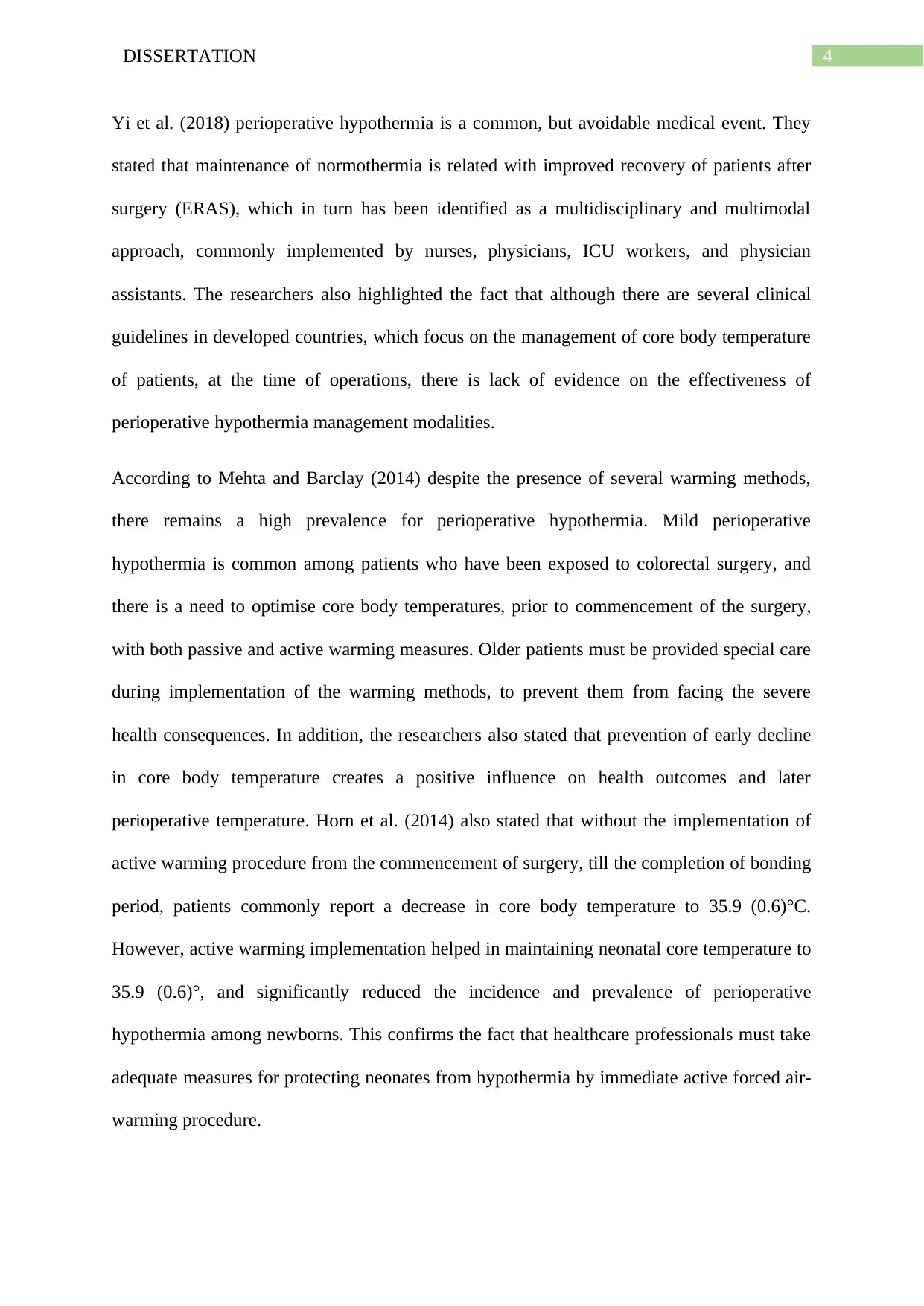
4DISSERTATION
Yi et al. (2018) perioperative hypothermia is a common, but avoidable medical event. They
stated that maintenance of normothermia is related with improved recovery of patients after
surgery (ERAS), which in turn has been identified as a multidisciplinary and multimodal
approach, commonly implemented by nurses, physicians, ICU workers, and physician
assistants. The researchers also highlighted the fact that although there are several clinical
guidelines in developed countries, which focus on the management of core body temperature
of patients, at the time of operations, there is lack of evidence on the effectiveness of
perioperative hypothermia management modalities.
According to Mehta and Barclay (2014) despite the presence of several warming methods,
there remains a high prevalence for perioperative hypothermia. Mild perioperative
hypothermia is common among patients who have been exposed to colorectal surgery, and
there is a need to optimise core body temperatures, prior to commencement of the surgery,
with both passive and active warming measures. Older patients must be provided special care
during implementation of the warming methods, to prevent them from facing the severe
health consequences. In addition, the researchers also stated that prevention of early decline
in core body temperature creates a positive influence on health outcomes and later
perioperative temperature. Horn et al. (2014) also stated that without the implementation of
active warming procedure from the commencement of surgery, till the completion of bonding
period, patients commonly report a decrease in core body temperature to 35.9 (0.6)°C.
However, active warming implementation helped in maintaining neonatal core temperature to
35.9 (0.6)°, and significantly reduced the incidence and prevalence of perioperative
hypothermia among newborns. This confirms the fact that healthcare professionals must take
adequate measures for protecting neonates from hypothermia by immediate active forced air-
warming procedure.
Yi et al. (2018) perioperative hypothermia is a common, but avoidable medical event. They
stated that maintenance of normothermia is related with improved recovery of patients after
surgery (ERAS), which in turn has been identified as a multidisciplinary and multimodal
approach, commonly implemented by nurses, physicians, ICU workers, and physician
assistants. The researchers also highlighted the fact that although there are several clinical
guidelines in developed countries, which focus on the management of core body temperature
of patients, at the time of operations, there is lack of evidence on the effectiveness of
perioperative hypothermia management modalities.
According to Mehta and Barclay (2014) despite the presence of several warming methods,
there remains a high prevalence for perioperative hypothermia. Mild perioperative
hypothermia is common among patients who have been exposed to colorectal surgery, and
there is a need to optimise core body temperatures, prior to commencement of the surgery,
with both passive and active warming measures. Older patients must be provided special care
during implementation of the warming methods, to prevent them from facing the severe
health consequences. In addition, the researchers also stated that prevention of early decline
in core body temperature creates a positive influence on health outcomes and later
perioperative temperature. Horn et al. (2014) also stated that without the implementation of
active warming procedure from the commencement of surgery, till the completion of bonding
period, patients commonly report a decrease in core body temperature to 35.9 (0.6)°C.
However, active warming implementation helped in maintaining neonatal core temperature to
35.9 (0.6)°, and significantly reduced the incidence and prevalence of perioperative
hypothermia among newborns. This confirms the fact that healthcare professionals must take
adequate measures for protecting neonates from hypothermia by immediate active forced air-
warming procedure.
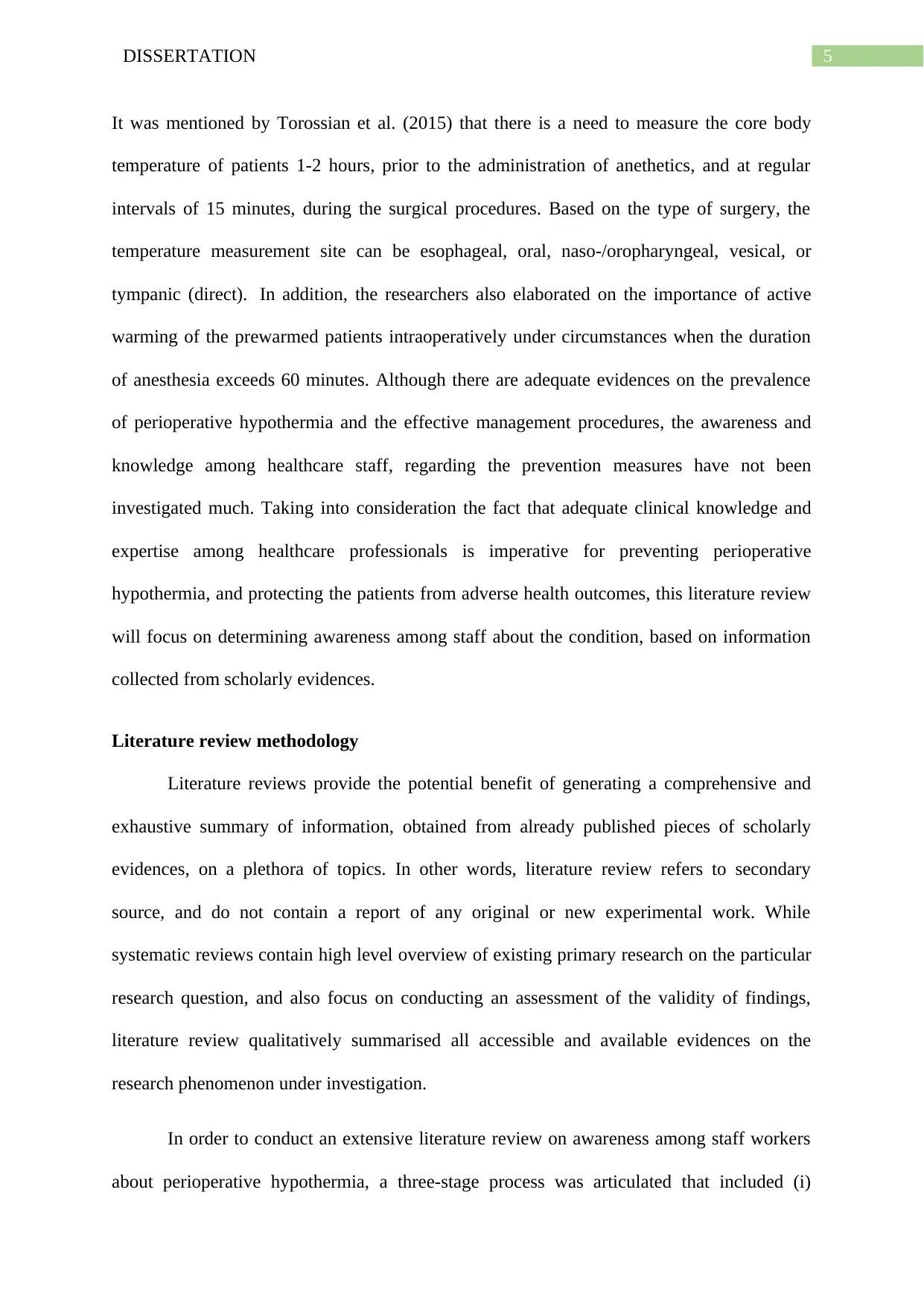
5DISSERTATION
It was mentioned by Torossian et al. (2015) that there is a need to measure the core body
temperature of patients 1-2 hours, prior to the administration of anethetics, and at regular
intervals of 15 minutes, during the surgical procedures. Based on the type of surgery, the
temperature measurement site can be esophageal, oral, naso-/oropharyngeal, vesical, or
tympanic (direct). In addition, the researchers also elaborated on the importance of active
warming of the prewarmed patients intraoperatively under circumstances when the duration
of anesthesia exceeds 60 minutes. Although there are adequate evidences on the prevalence
of perioperative hypothermia and the effective management procedures, the awareness and
knowledge among healthcare staff, regarding the prevention measures have not been
investigated much. Taking into consideration the fact that adequate clinical knowledge and
expertise among healthcare professionals is imperative for preventing perioperative
hypothermia, and protecting the patients from adverse health outcomes, this literature review
will focus on determining awareness among staff about the condition, based on information
collected from scholarly evidences.
Literature review methodology
Literature reviews provide the potential benefit of generating a comprehensive and
exhaustive summary of information, obtained from already published pieces of scholarly
evidences, on a plethora of topics. In other words, literature review refers to secondary
source, and do not contain a report of any original or new experimental work. While
systematic reviews contain high level overview of existing primary research on the particular
research question, and also focus on conducting an assessment of the validity of findings,
literature review qualitatively summarised all accessible and available evidences on the
research phenomenon under investigation.
In order to conduct an extensive literature review on awareness among staff workers
about perioperative hypothermia, a three-stage process was articulated that included (i)
It was mentioned by Torossian et al. (2015) that there is a need to measure the core body
temperature of patients 1-2 hours, prior to the administration of anethetics, and at regular
intervals of 15 minutes, during the surgical procedures. Based on the type of surgery, the
temperature measurement site can be esophageal, oral, naso-/oropharyngeal, vesical, or
tympanic (direct). In addition, the researchers also elaborated on the importance of active
warming of the prewarmed patients intraoperatively under circumstances when the duration
of anesthesia exceeds 60 minutes. Although there are adequate evidences on the prevalence
of perioperative hypothermia and the effective management procedures, the awareness and
knowledge among healthcare staff, regarding the prevention measures have not been
investigated much. Taking into consideration the fact that adequate clinical knowledge and
expertise among healthcare professionals is imperative for preventing perioperative
hypothermia, and protecting the patients from adverse health outcomes, this literature review
will focus on determining awareness among staff about the condition, based on information
collected from scholarly evidences.
Literature review methodology
Literature reviews provide the potential benefit of generating a comprehensive and
exhaustive summary of information, obtained from already published pieces of scholarly
evidences, on a plethora of topics. In other words, literature review refers to secondary
source, and do not contain a report of any original or new experimental work. While
systematic reviews contain high level overview of existing primary research on the particular
research question, and also focus on conducting an assessment of the validity of findings,
literature review qualitatively summarised all accessible and available evidences on the
research phenomenon under investigation.
In order to conduct an extensive literature review on awareness among staff workers
about perioperative hypothermia, a three-stage process was articulated that included (i)
⊘ This is a preview!⊘
Do you want full access?
Subscribe today to unlock all pages.

Trusted by 1+ million students worldwide
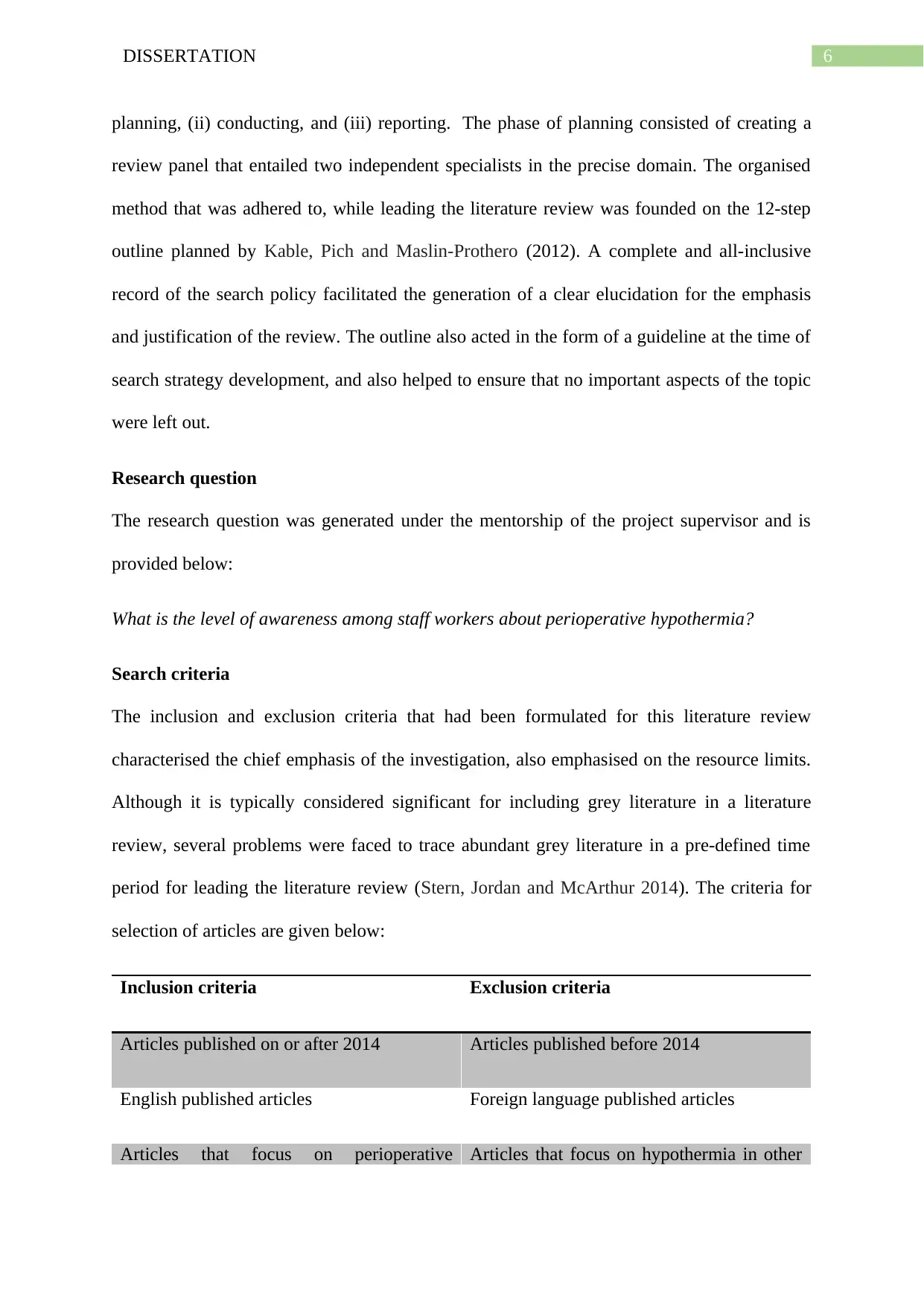
6DISSERTATION
planning, (ii) conducting, and (iii) reporting. The phase of planning consisted of creating a
review panel that entailed two independent specialists in the precise domain. The organised
method that was adhered to, while leading the literature review was founded on the 12-step
outline planned by Kable, Pich and Maslin-Prothero (2012). A complete and all-inclusive
record of the search policy facilitated the generation of a clear elucidation for the emphasis
and justification of the review. The outline also acted in the form of a guideline at the time of
search strategy development, and also helped to ensure that no important aspects of the topic
were left out.
Research question
The research question was generated under the mentorship of the project supervisor and is
provided below:
What is the level of awareness among staff workers about perioperative hypothermia?
Search criteria
The inclusion and exclusion criteria that had been formulated for this literature review
characterised the chief emphasis of the investigation, also emphasised on the resource limits.
Although it is typically considered significant for including grey literature in a literature
review, several problems were faced to trace abundant grey literature in a pre-defined time
period for leading the literature review (Stern, Jordan and McArthur 2014). The criteria for
selection of articles are given below:
Inclusion criteria Exclusion criteria
Articles published on or after 2014 Articles published before 2014
English published articles Foreign language published articles
Articles that focus on perioperative Articles that focus on hypothermia in other
planning, (ii) conducting, and (iii) reporting. The phase of planning consisted of creating a
review panel that entailed two independent specialists in the precise domain. The organised
method that was adhered to, while leading the literature review was founded on the 12-step
outline planned by Kable, Pich and Maslin-Prothero (2012). A complete and all-inclusive
record of the search policy facilitated the generation of a clear elucidation for the emphasis
and justification of the review. The outline also acted in the form of a guideline at the time of
search strategy development, and also helped to ensure that no important aspects of the topic
were left out.
Research question
The research question was generated under the mentorship of the project supervisor and is
provided below:
What is the level of awareness among staff workers about perioperative hypothermia?
Search criteria
The inclusion and exclusion criteria that had been formulated for this literature review
characterised the chief emphasis of the investigation, also emphasised on the resource limits.
Although it is typically considered significant for including grey literature in a literature
review, several problems were faced to trace abundant grey literature in a pre-defined time
period for leading the literature review (Stern, Jordan and McArthur 2014). The criteria for
selection of articles are given below:
Inclusion criteria Exclusion criteria
Articles published on or after 2014 Articles published before 2014
English published articles Foreign language published articles
Articles that focus on perioperative Articles that focus on hypothermia in other
Paraphrase This Document
Need a fresh take? Get an instant paraphrase of this document with our AI Paraphraser
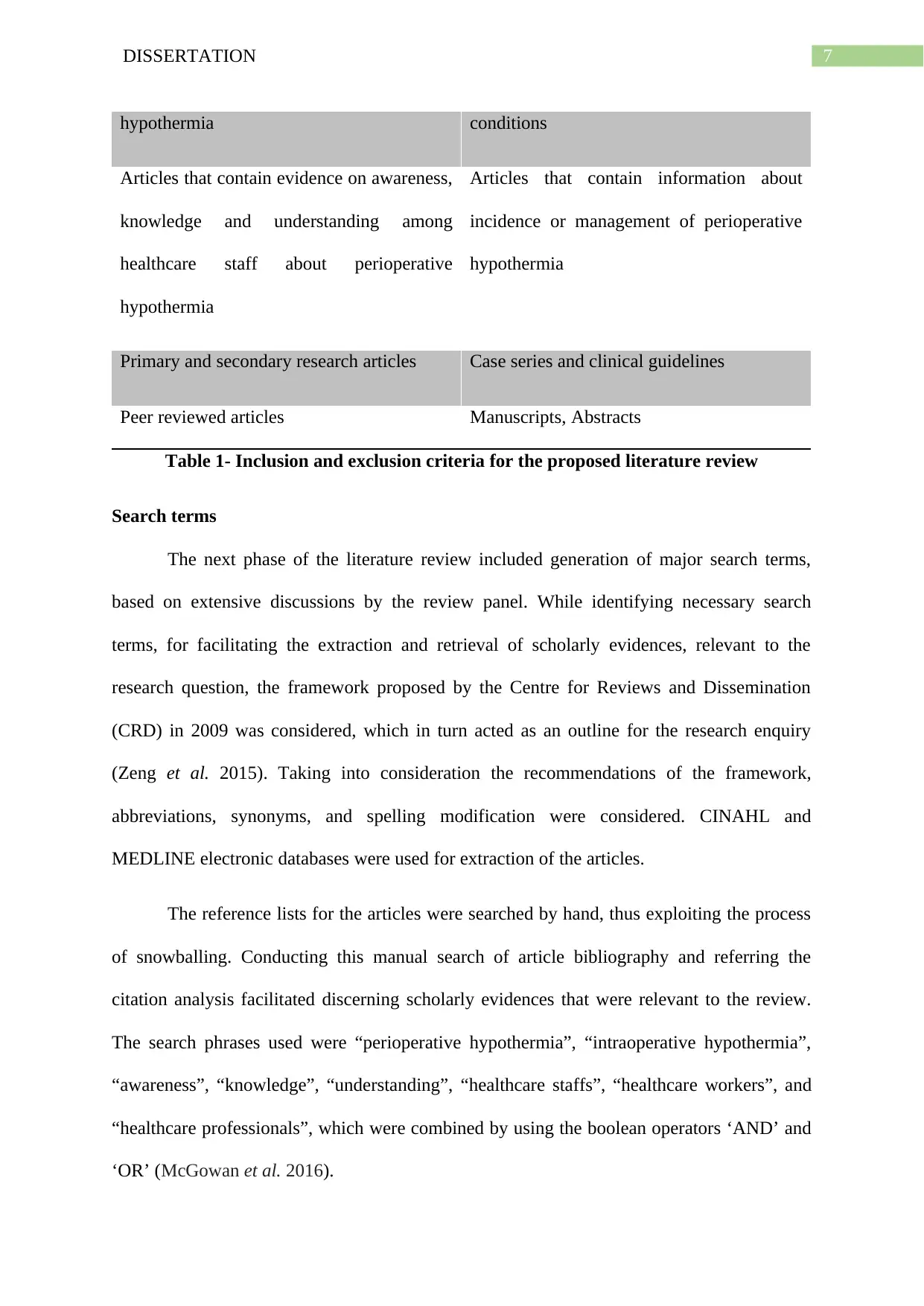
7DISSERTATION
hypothermia conditions
Articles that contain evidence on awareness,
knowledge and understanding among
healthcare staff about perioperative
hypothermia
Articles that contain information about
incidence or management of perioperative
hypothermia
Primary and secondary research articles Case series and clinical guidelines
Peer reviewed articles Manuscripts, Abstracts
Table 1- Inclusion and exclusion criteria for the proposed literature review
Search terms
The next phase of the literature review included generation of major search terms,
based on extensive discussions by the review panel. While identifying necessary search
terms, for facilitating the extraction and retrieval of scholarly evidences, relevant to the
research question, the framework proposed by the Centre for Reviews and Dissemination
(CRD) in 2009 was considered, which in turn acted as an outline for the research enquiry
(Zeng et al. 2015). Taking into consideration the recommendations of the framework,
abbreviations, synonyms, and spelling modification were considered. CINAHL and
MEDLINE electronic databases were used for extraction of the articles.
The reference lists for the articles were searched by hand, thus exploiting the process
of snowballing. Conducting this manual search of article bibliography and referring the
citation analysis facilitated discerning scholarly evidences that were relevant to the review.
The search phrases used were “perioperative hypothermia”, “intraoperative hypothermia”,
“awareness”, “knowledge”, “understanding”, “healthcare staffs”, “healthcare workers”, and
“healthcare professionals”, which were combined by using the boolean operators ‘AND’ and
‘OR’ (McGowan et al. 2016).
hypothermia conditions
Articles that contain evidence on awareness,
knowledge and understanding among
healthcare staff about perioperative
hypothermia
Articles that contain information about
incidence or management of perioperative
hypothermia
Primary and secondary research articles Case series and clinical guidelines
Peer reviewed articles Manuscripts, Abstracts
Table 1- Inclusion and exclusion criteria for the proposed literature review
Search terms
The next phase of the literature review included generation of major search terms,
based on extensive discussions by the review panel. While identifying necessary search
terms, for facilitating the extraction and retrieval of scholarly evidences, relevant to the
research question, the framework proposed by the Centre for Reviews and Dissemination
(CRD) in 2009 was considered, which in turn acted as an outline for the research enquiry
(Zeng et al. 2015). Taking into consideration the recommendations of the framework,
abbreviations, synonyms, and spelling modification were considered. CINAHL and
MEDLINE electronic databases were used for extraction of the articles.
The reference lists for the articles were searched by hand, thus exploiting the process
of snowballing. Conducting this manual search of article bibliography and referring the
citation analysis facilitated discerning scholarly evidences that were relevant to the review.
The search phrases used were “perioperative hypothermia”, “intraoperative hypothermia”,
“awareness”, “knowledge”, “understanding”, “healthcare staffs”, “healthcare workers”, and
“healthcare professionals”, which were combined by using the boolean operators ‘AND’ and
‘OR’ (McGowan et al. 2016).

8DISSERTATION
Literature appraisal
According to Giuliano and Hendricks (2017) unintentional perioperative hypothermia has
been found to create an impact on an estimated 70% of patients undergoing surgery, and is
also related with hostile clinical outcomes, increase in the length of hospital stays, and
augmented healthcare costs. The researchers were accurate in identifying the fact that nursing
professionals play an important role in monitoring and providing care to all surgical patients,
during the course of the perioperative continuum. This calls for the need of increasing their
perception and understanding regarding perioperative hypothermia, with the aim of
enhancing patient outcomes
In order to gain a sound understanding of the present extent of nursing awareness and
familiarity on the phenomenon, the researchers were accurately conducted an e‐mail
examination of the AORN members. They obtained an overall response rate of 6.5% (N =
324), in addition to the fact that most of the nursing staff who responded were found to either
overestimate or underestimate the lower or upper parameters for normothermia. On being
questioned about the complication that was most commonly related with hypothermia,
surgical site infections (65.4%), shivering (68.2%), and cardiac events (61.7%) were
identified by the respondents. However, only 33.6% and 44.8% identified pressure injuries
and blood loss, respectively. Nonetheless, the research had several limitations such as,
recruitment of nursing professionals in a non-random fashion, small sample size and low
response rate. In addition, most of the study subjects had adequate experience and
knowledge, which might not always be the case in real-time settings. Hence, the results
facilitated identification of the need to increase perception and awareness by promoting best
practices.
The findings were congruent with those of Purnamasari, Rustina and Waluyanti (2017) who
based their research on the fact that newborns are at an increased risk of hypothermia owing
Literature appraisal
According to Giuliano and Hendricks (2017) unintentional perioperative hypothermia has
been found to create an impact on an estimated 70% of patients undergoing surgery, and is
also related with hostile clinical outcomes, increase in the length of hospital stays, and
augmented healthcare costs. The researchers were accurate in identifying the fact that nursing
professionals play an important role in monitoring and providing care to all surgical patients,
during the course of the perioperative continuum. This calls for the need of increasing their
perception and understanding regarding perioperative hypothermia, with the aim of
enhancing patient outcomes
In order to gain a sound understanding of the present extent of nursing awareness and
familiarity on the phenomenon, the researchers were accurately conducted an e‐mail
examination of the AORN members. They obtained an overall response rate of 6.5% (N =
324), in addition to the fact that most of the nursing staff who responded were found to either
overestimate or underestimate the lower or upper parameters for normothermia. On being
questioned about the complication that was most commonly related with hypothermia,
surgical site infections (65.4%), shivering (68.2%), and cardiac events (61.7%) were
identified by the respondents. However, only 33.6% and 44.8% identified pressure injuries
and blood loss, respectively. Nonetheless, the research had several limitations such as,
recruitment of nursing professionals in a non-random fashion, small sample size and low
response rate. In addition, most of the study subjects had adequate experience and
knowledge, which might not always be the case in real-time settings. Hence, the results
facilitated identification of the need to increase perception and awareness by promoting best
practices.
The findings were congruent with those of Purnamasari, Rustina and Waluyanti (2017) who
based their research on the fact that newborns are at an increased risk of hypothermia owing
⊘ This is a preview!⊘
Do you want full access?
Subscribe today to unlock all pages.

Trusted by 1+ million students worldwide
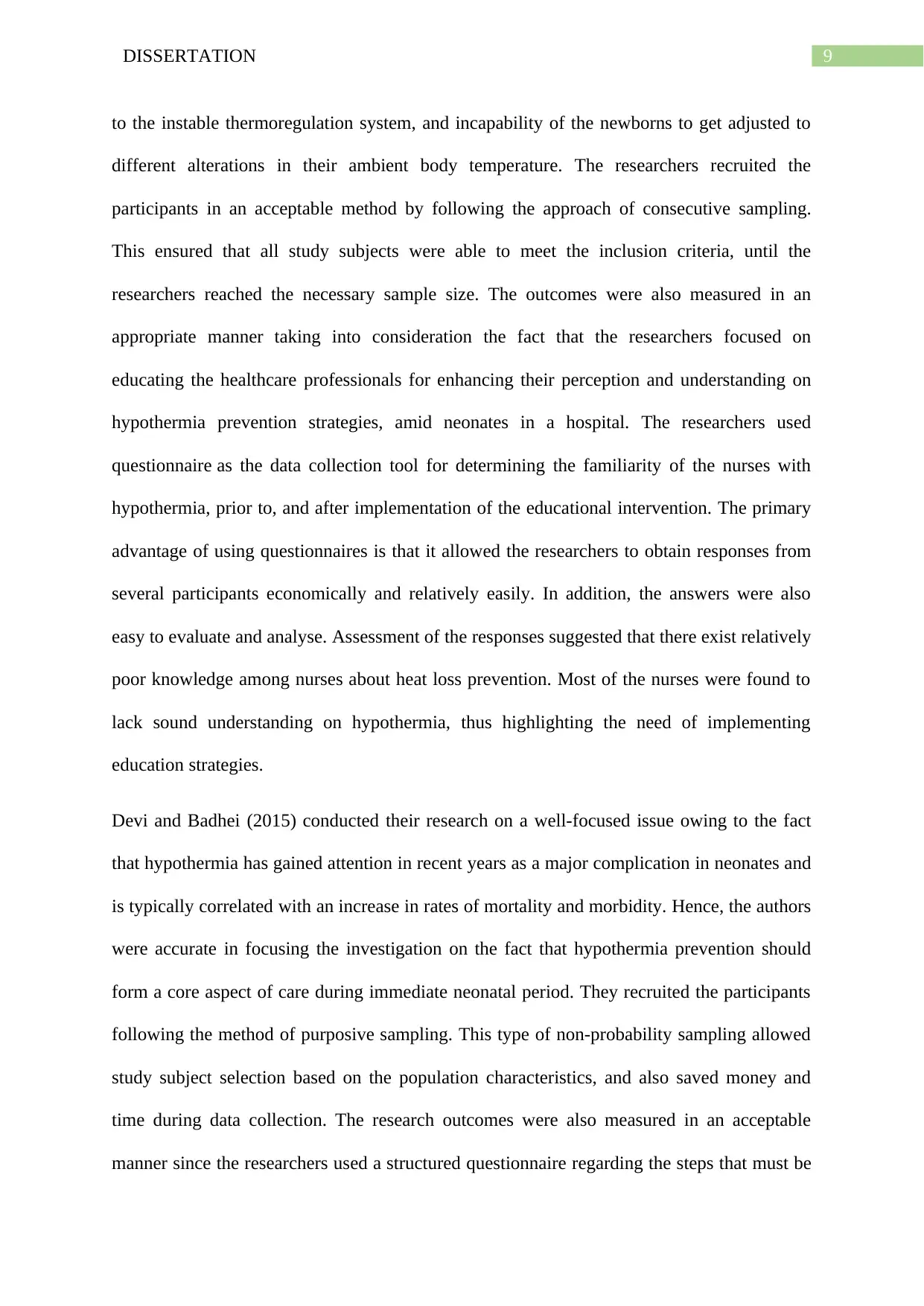
9DISSERTATION
to the instable thermoregulation system, and incapability of the newborns to get adjusted to
different alterations in their ambient body temperature. The researchers recruited the
participants in an acceptable method by following the approach of consecutive sampling.
This ensured that all study subjects were able to meet the inclusion criteria, until the
researchers reached the necessary sample size. The outcomes were also measured in an
appropriate manner taking into consideration the fact that the researchers focused on
educating the healthcare professionals for enhancing their perception and understanding on
hypothermia prevention strategies, amid neonates in a hospital. The researchers used
questionnaire as the data collection tool for determining the familiarity of the nurses with
hypothermia, prior to, and after implementation of the educational intervention. The primary
advantage of using questionnaires is that it allowed the researchers to obtain responses from
several participants economically and relatively easily. In addition, the answers were also
easy to evaluate and analyse. Assessment of the responses suggested that there exist relatively
poor knowledge among nurses about heat loss prevention. Most of the nurses were found to
lack sound understanding on hypothermia, thus highlighting the need of implementing
education strategies.
Devi and Badhei (2015) conducted their research on a well-focused issue owing to the fact
that hypothermia has gained attention in recent years as a major complication in neonates and
is typically correlated with an increase in rates of mortality and morbidity. Hence, the authors
were accurate in focusing the investigation on the fact that hypothermia prevention should
form a core aspect of care during immediate neonatal period. They recruited the participants
following the method of purposive sampling. This type of non-probability sampling allowed
study subject selection based on the population characteristics, and also saved money and
time during data collection. The research outcomes were also measured in an acceptable
manner since the researchers used a structured questionnaire regarding the steps that must be
to the instable thermoregulation system, and incapability of the newborns to get adjusted to
different alterations in their ambient body temperature. The researchers recruited the
participants in an acceptable method by following the approach of consecutive sampling.
This ensured that all study subjects were able to meet the inclusion criteria, until the
researchers reached the necessary sample size. The outcomes were also measured in an
appropriate manner taking into consideration the fact that the researchers focused on
educating the healthcare professionals for enhancing their perception and understanding on
hypothermia prevention strategies, amid neonates in a hospital. The researchers used
questionnaire as the data collection tool for determining the familiarity of the nurses with
hypothermia, prior to, and after implementation of the educational intervention. The primary
advantage of using questionnaires is that it allowed the researchers to obtain responses from
several participants economically and relatively easily. In addition, the answers were also
easy to evaluate and analyse. Assessment of the responses suggested that there exist relatively
poor knowledge among nurses about heat loss prevention. Most of the nurses were found to
lack sound understanding on hypothermia, thus highlighting the need of implementing
education strategies.
Devi and Badhei (2015) conducted their research on a well-focused issue owing to the fact
that hypothermia has gained attention in recent years as a major complication in neonates and
is typically correlated with an increase in rates of mortality and morbidity. Hence, the authors
were accurate in focusing the investigation on the fact that hypothermia prevention should
form a core aspect of care during immediate neonatal period. They recruited the participants
following the method of purposive sampling. This type of non-probability sampling allowed
study subject selection based on the population characteristics, and also saved money and
time during data collection. The research outcomes were also measured in an acceptable
manner since the researchers used a structured questionnaire regarding the steps that must be
Paraphrase This Document
Need a fresh take? Get an instant paraphrase of this document with our AI Paraphraser
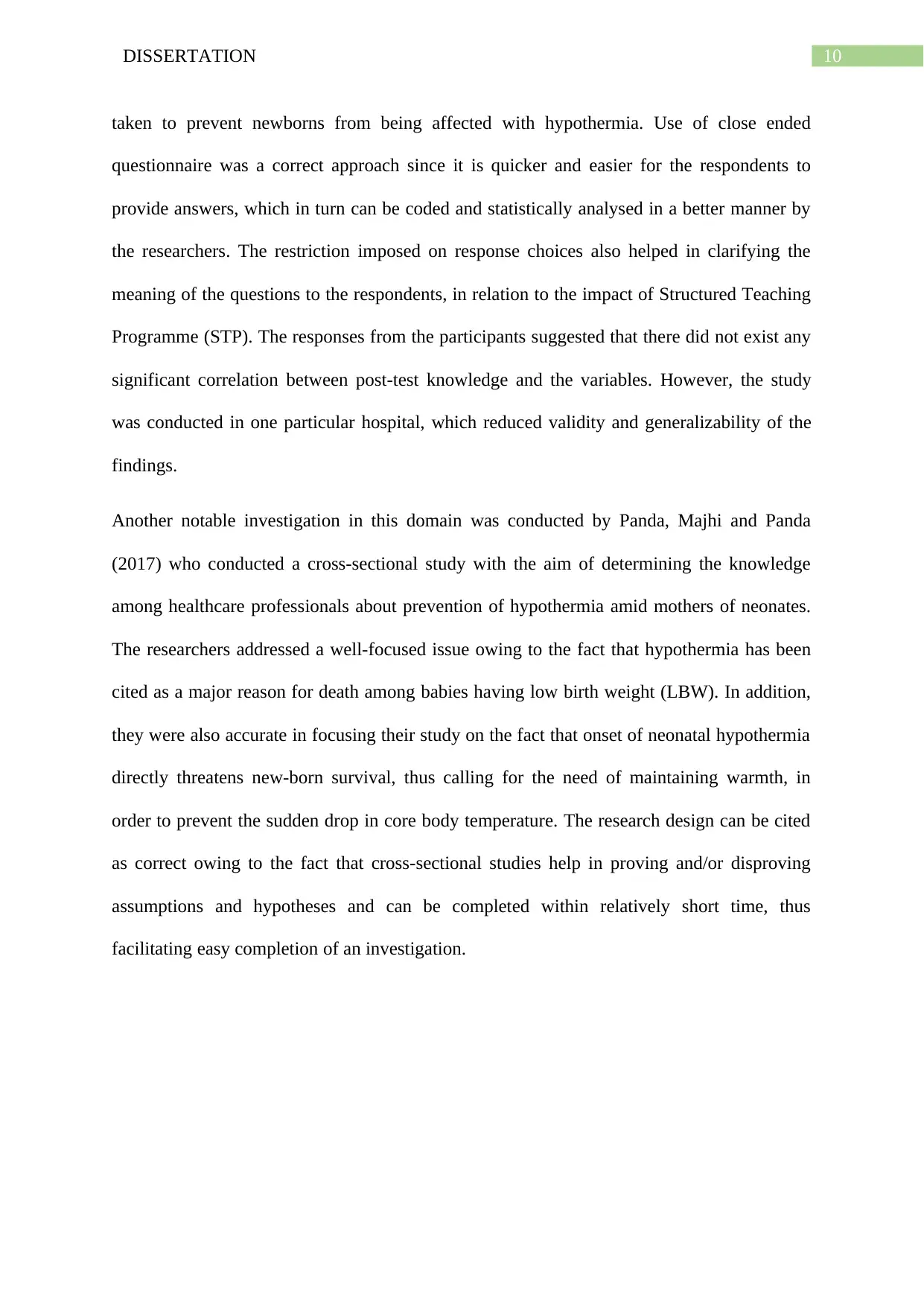
10DISSERTATION
taken to prevent newborns from being affected with hypothermia. Use of close ended
questionnaire was a correct approach since it is quicker and easier for the respondents to
provide answers, which in turn can be coded and statistically analysed in a better manner by
the researchers. The restriction imposed on response choices also helped in clarifying the
meaning of the questions to the respondents, in relation to the impact of Structured Teaching
Programme (STP). The responses from the participants suggested that there did not exist any
significant correlation between post-test knowledge and the variables. However, the study
was conducted in one particular hospital, which reduced validity and generalizability of the
findings.
Another notable investigation in this domain was conducted by Panda, Majhi and Panda
(2017) who conducted a cross-sectional study with the aim of determining the knowledge
among healthcare professionals about prevention of hypothermia amid mothers of neonates.
The researchers addressed a well-focused issue owing to the fact that hypothermia has been
cited as a major reason for death among babies having low birth weight (LBW). In addition,
they were also accurate in focusing their study on the fact that onset of neonatal hypothermia
directly threatens new-born survival, thus calling for the need of maintaining warmth, in
order to prevent the sudden drop in core body temperature. The research design can be cited
as correct owing to the fact that cross-sectional studies help in proving and/or disproving
assumptions and hypotheses and can be completed within relatively short time, thus
facilitating easy completion of an investigation.
taken to prevent newborns from being affected with hypothermia. Use of close ended
questionnaire was a correct approach since it is quicker and easier for the respondents to
provide answers, which in turn can be coded and statistically analysed in a better manner by
the researchers. The restriction imposed on response choices also helped in clarifying the
meaning of the questions to the respondents, in relation to the impact of Structured Teaching
Programme (STP). The responses from the participants suggested that there did not exist any
significant correlation between post-test knowledge and the variables. However, the study
was conducted in one particular hospital, which reduced validity and generalizability of the
findings.
Another notable investigation in this domain was conducted by Panda, Majhi and Panda
(2017) who conducted a cross-sectional study with the aim of determining the knowledge
among healthcare professionals about prevention of hypothermia amid mothers of neonates.
The researchers addressed a well-focused issue owing to the fact that hypothermia has been
cited as a major reason for death among babies having low birth weight (LBW). In addition,
they were also accurate in focusing their study on the fact that onset of neonatal hypothermia
directly threatens new-born survival, thus calling for the need of maintaining warmth, in
order to prevent the sudden drop in core body temperature. The research design can be cited
as correct owing to the fact that cross-sectional studies help in proving and/or disproving
assumptions and hypotheses and can be completed within relatively short time, thus
facilitating easy completion of an investigation.
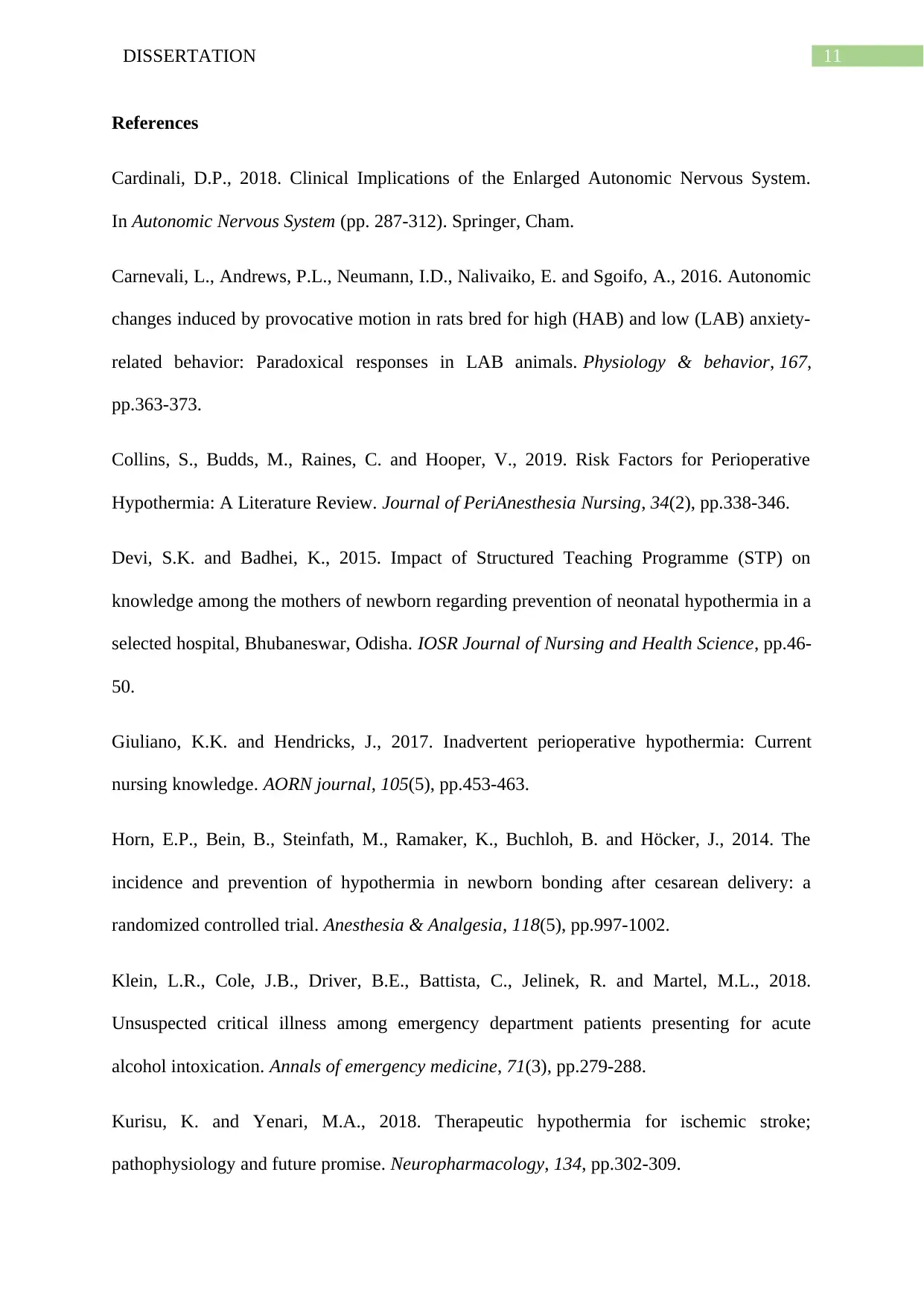
11DISSERTATION
References
Cardinali, D.P., 2018. Clinical Implications of the Enlarged Autonomic Nervous System.
In Autonomic Nervous System (pp. 287-312). Springer, Cham.
Carnevali, L., Andrews, P.L., Neumann, I.D., Nalivaiko, E. and Sgoifo, A., 2016. Autonomic
changes induced by provocative motion in rats bred for high (HAB) and low (LAB) anxiety-
related behavior: Paradoxical responses in LAB animals. Physiology & behavior, 167,
pp.363-373.
Collins, S., Budds, M., Raines, C. and Hooper, V., 2019. Risk Factors for Perioperative
Hypothermia: A Literature Review. Journal of PeriAnesthesia Nursing, 34(2), pp.338-346.
Devi, S.K. and Badhei, K., 2015. Impact of Structured Teaching Programme (STP) on
knowledge among the mothers of newborn regarding prevention of neonatal hypothermia in a
selected hospital, Bhubaneswar, Odisha. IOSR Journal of Nursing and Health Science, pp.46-
50.
Giuliano, K.K. and Hendricks, J., 2017. Inadvertent perioperative hypothermia: Current
nursing knowledge. AORN journal, 105(5), pp.453-463.
Horn, E.P., Bein, B., Steinfath, M., Ramaker, K., Buchloh, B. and Höcker, J., 2014. The
incidence and prevention of hypothermia in newborn bonding after cesarean delivery: a
randomized controlled trial. Anesthesia & Analgesia, 118(5), pp.997-1002.
Klein, L.R., Cole, J.B., Driver, B.E., Battista, C., Jelinek, R. and Martel, M.L., 2018.
Unsuspected critical illness among emergency department patients presenting for acute
alcohol intoxication. Annals of emergency medicine, 71(3), pp.279-288.
Kurisu, K. and Yenari, M.A., 2018. Therapeutic hypothermia for ischemic stroke;
pathophysiology and future promise. Neuropharmacology, 134, pp.302-309.
References
Cardinali, D.P., 2018. Clinical Implications of the Enlarged Autonomic Nervous System.
In Autonomic Nervous System (pp. 287-312). Springer, Cham.
Carnevali, L., Andrews, P.L., Neumann, I.D., Nalivaiko, E. and Sgoifo, A., 2016. Autonomic
changes induced by provocative motion in rats bred for high (HAB) and low (LAB) anxiety-
related behavior: Paradoxical responses in LAB animals. Physiology & behavior, 167,
pp.363-373.
Collins, S., Budds, M., Raines, C. and Hooper, V., 2019. Risk Factors for Perioperative
Hypothermia: A Literature Review. Journal of PeriAnesthesia Nursing, 34(2), pp.338-346.
Devi, S.K. and Badhei, K., 2015. Impact of Structured Teaching Programme (STP) on
knowledge among the mothers of newborn regarding prevention of neonatal hypothermia in a
selected hospital, Bhubaneswar, Odisha. IOSR Journal of Nursing and Health Science, pp.46-
50.
Giuliano, K.K. and Hendricks, J., 2017. Inadvertent perioperative hypothermia: Current
nursing knowledge. AORN journal, 105(5), pp.453-463.
Horn, E.P., Bein, B., Steinfath, M., Ramaker, K., Buchloh, B. and Höcker, J., 2014. The
incidence and prevention of hypothermia in newborn bonding after cesarean delivery: a
randomized controlled trial. Anesthesia & Analgesia, 118(5), pp.997-1002.
Klein, L.R., Cole, J.B., Driver, B.E., Battista, C., Jelinek, R. and Martel, M.L., 2018.
Unsuspected critical illness among emergency department patients presenting for acute
alcohol intoxication. Annals of emergency medicine, 71(3), pp.279-288.
Kurisu, K. and Yenari, M.A., 2018. Therapeutic hypothermia for ischemic stroke;
pathophysiology and future promise. Neuropharmacology, 134, pp.302-309.
⊘ This is a preview!⊘
Do you want full access?
Subscribe today to unlock all pages.

Trusted by 1+ million students worldwide
1 out of 15
Related Documents
Your All-in-One AI-Powered Toolkit for Academic Success.
+13062052269
info@desklib.com
Available 24*7 on WhatsApp / Email
![[object Object]](/_next/static/media/star-bottom.7253800d.svg)
Unlock your academic potential
Copyright © 2020–2025 A2Z Services. All Rights Reserved. Developed and managed by ZUCOL.





